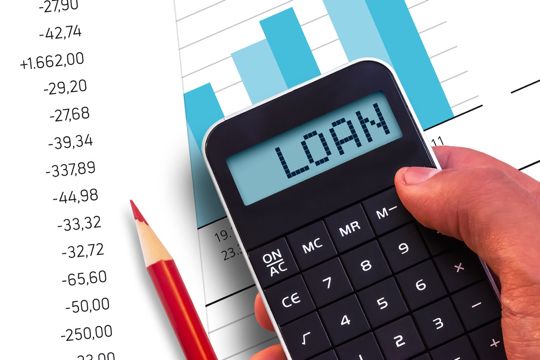Physical Address
60 Ekwema Cres, Layout 460281, Imo
Physical Address
60 Ekwema Cres, Layout 460281, Imo

A loan calculator can be a very useful tool if you are considering taking out a loan and would like to know how much the installments will be before applying.
The purpose of a loan calculator is to assist borrowers in figuring out amortised loans. These include personal loans such as mortgages, vehicle loans, school loans, and others that have fixed payments that cover both the principal and interest and are repaid over time in regular installments.
You can see the entire cost of a loan with a loan calculator, which displays the annual percentage rate, or APR. To view your customised results, enter the loan amount, term, and interest rate in the areas below and click calculate.
Based on the loan amount, interest rate, and payback period, a personal loan calculator displays your monthly payments. It additionally displays the overall cost of borrowing money, whether the origination charge is included or not. You can use the loan calculator to see if a personal loan is the best financing choice for your goals.
Read also – South Africa’s Corporate Registration Breached by Hackers

Loan levels for personal use range from $1,000 to $100,000. Large loan amounts are more likely to be approved for borrowers with good credit and income.
The main factors influencing your personal loan interest rate are your financial situation and credit history. Rates are typically lowest for borrowers with good credit and low debt-to-income ratios.
The normal repayment period for a personal loan is two to seven years. A shorter-term loan has lower interest costs, but a longer-term loan has larger monthly payments. Select a payback period on the loan calculator that strikes a balance between low interest rates and manageable installments.
Your first payment is due on this date. Thirty days following the loan’s funding, many lenders demand the first payment.
An origination fee, which typically ranges from 1% to 10% of the loan amount, is the portion of the loan that goes to the lender. An origination fee is not a requirement for all lenders. When you receive a loan offer, you usually find out whether you’ll pay it and how much it is.
Read also – Bolt Rewards Programme: Bolt Nigeria is Offering Drivers Fuel and Insurance Discounts
The total amount owed to the lender throughout the course of the loan, paid each month. Each payment has a portion allocated to interest and the remainder to principle.
The entire principal that you are borrowing. Your loan amount will be matched.
The total amount of interest only that you will pay for the duration of the loan.
The interest paid on the loan is equal to the principal amount plus interest.
The last day you’ll make loan payments. The payoff date is determined by your loan term and start date.
It is a table that illustrates the principal and interest amounts for each monthly payment.
Before providing you money, lenders frequently deduct an origination charge, which lowers the total loan amount. The results of your loan calculator will change based on how the fee is applied.
If you added an origination charge, here’s how to interpret your results.
When evaluating personal loans, pay close attention to the loan interest rate, total cost of borrowing, and loan amount monthly payment.
Making your personal loan payments on time can help you establish credit; missing or late payments will damage it. Your monthly budget should allow for the comfortable payment of your loans.
You can compare the costs of different loans by examining the total loan interest paid on its own. It can also serve as a gut-check to determine whether the loan is worthwhile.
It is the best way to compare loan calculator costs because it shows how much borrowing will cost. Before you are approved for a loan, a lender must provide this number to you. The APR and interest rate of a personal loan only alter if additional costs, such as an origination fee, are incurred.
A reasonable monthly payment and low overall interest rates are characteristics of a good personal loan rate. It is least expensive to take out a loan with the lowest rate.
The credit profile and history, income, and outstanding debts are factors by a loan calculator in getting your loan interest rate. The typical rates for personal loans in each credit score range are listed here.
| Borrower credit rating | Score range | Estimated APR |
| Exellent | 720-850 | 12.42% |
| Good | 690-719 | 14.82% |
| Fair | 630-689 | 18.82% |
| Bad | 300-629 | 21.10% |
Read also – VULTe: Up to N100 Million Available to Expand Your Business
After figuring out interest rates and monthly payments, it’s time to apply for loans and compare offers. What comes next is as follows:
You can pre-qualify for a personal loan from a number of online, bank, and credit union lenders. The lender will run a mild credit check to ascertain what loan amount, rate, and payback period you may qualify for after you provide them with some personal information about yourself, such as your name, income, desired loan amount, and loan purpose. Get pre-approved by a few lenders to compare offers.
The best loan offer is usually the one with the lowest loan interest rate and the most manageable monthly installments. To break a tie between two or more attractive offers, compare their unique qualities. Certain lenders offer quick finance, unemployment insurance, and credit-building resources.
Once your offer is pre-qualified, accept it and complete the official lender application. This is when the lender pulls your credit report, which temporarily lowers your score. Having your W-2s and tax returns ready, along with other documentation proving your identification and income, will expedite the application process.
Obtain funding. Most personal loan lenders can fund a loan in as little as one week if it is accepted. Some promise to send you the funds the same day or the following working day.
Read also – Hustler Fund Loan and How to Apply
The cost of a loan is determined by the loan type, the lender, the state of the market, your income, and your credit history. It’s crucial to check your credit score before looking for a loan since it will enable you to focus just on lenders who provide credit to consumers who fit your credit profile. Nevertheless, you must have good to exceptional credit (a FICO score of 740 and above) in order to obtain the greatest interest rates.
Utilising a loan calculator is a smart notion prior to looking for any kind of loan. By displaying the monthly payment you can afford, a calculator can assist you in focusing your search for a house or vehicle. It can assist you in comparing loan prices and determining how, particularly in the case of mortgages, variations in interest rates may impact your payments.
On the other hand, you can use an interest rate calculator to figure out how much of a monthly payment you should be making in order to lower the amount of interest you pay. It’s essential to use a calculator while taking out a loan in order to make wise financial decisions.
Read also – Zenka Loan App: How to get Mobile Loan in 5 Minutes
Here are some specifics regarding the most typical loan kinds along with loan calculators to aid you in the approach.

Once you enter the price of the home, your down payment, the interest rate, and the length of the loan term, a mortgage loan calculator estimates your monthly payment. Try putting several scenarios’ prices into the loan calculator.
You may find that in order to maintain affordable monthly payments, you need to modify your down payment. Additionally, you may view the loan amortisation schedule, which shows you how monthly principal and interest payments will gradually lower your debt.
You can use the calculator to see how much more you need to pay each month to reach your objective of paying off a mortgage before the loan term expires.
Various questions can be answered by other mortgage loan calculators: What is your debt-to-income ratio, or DTI? Lenders use that percentage to determine how much debt you have. Which mortgage term is better, 15 or 30 years? Variable or fixed interest rates?
Since a mortgage is a loan that is secured by the residence itself, it is imperative to have the numbers down before purchasing a property. The lender has the right to foreclose and take your property if you don’t make the monthly payments.
Homeowners who wish to borrow against some of their equity to cover expenses such as college tuition, a dream vacation, home improvements, or other needs can apply for home equity loans, often known as second mortgages.
A home equity loan calculator is a one-time, lump-sum loan that is typically paid back over five to twenty years at a fixed rate. With the use of home equity loan calculator, you may ascertain your potential borrowing capacity based on your loan-to-value ratio (LTV), which is the difference between the amount you owe on your property and its market value.
A home equity loan that functions more like a credit card is called a HELOC. As you pay back the loan, you can use the credit line that you are provided again.
Typically, the loan interest rate fluctuates and is based on an index, like the prime rate. Many questions can be answered by our home equity calculators, including:

A secured loan used to purchase a car is called an auto loan. You can examine the loan amortisation schedule, total interest amount, and estimated monthly payments using the auto loan calculator.
Costs including taxes, auto registration, and documentation fees are not included in the calculator. Ten percent or so should be added to your estimate.

An unsecured loan from the federal government or a private lender is known as a student loan. For private student loans, borrowers must be eligible. It might not be possible to locate the best loan if you don’t have a long credit history.
You can find out how long it will take to pay off your loan and how much interest it will cost by using college savings loan calculator. You can create future savings objectives with the aid of the college savings calculator.
A personal loan is an unsecured, one-time payment that has a set rate of return and a predetermined repayment period. Because it can be used for debt consolidation, paying off high-interest credit cards, home improvements, wedding or vacation expenses, the purchase of a boat or RV, or other large purchases, it is a versatile loan.
Using the personal loan calculator, you can calculate your estimated monthly payments according to your income, credit score, repayment terms, desired loan amount, interest rate, and length of loan.
A loan calculator is a financial tool designed to help individuals estimate their loan repayments based on various factors such as loan amount, interest rate, and repayment period.
By using a loan calculator, borrowers can get a clear understanding of how different loan terms, such as loan amount, interest rate, and repayment period, impact their monthly repayments.
While loan calculators provide estimates of loan repayments based on the information entered by the user, it’s important to note that these estimates are approximate and may not reflect the exact repayment amount.
In conclusion, loan calculators serve as invaluable tools for borrowers, offering insights into potential loan repayments and aiding in informed financial decision-making. By utilizing these calculators, individuals can assess various loan scenarios, understand the implications of different terms, and plan their finances effectively.
While loan calculators provide estimates, they empower borrowers to navigate borrowing with confidence and transparency. Ultimately, by leveraging loan calculators, borrowers can make informed choices that align with their financial goals and ensure responsible management of their loans.